Following the route of the stars
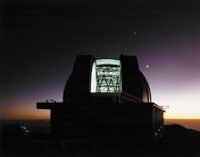
The particularity of the Grantecan telescope is found in its basic mirror. This mirror has a diameter of 10.4 meters, with which the human being will have the most demanding look so far. The telescope, if there are no delays, will receive the first image in 2004 and from then on we will know more in detail the universe. In addition, the new telescope will improve its accuracy over the years as it incorporates error detection and correction systems.
Thus, the solar system, planets of other galaxies, weak stars, star formation, black holes, distant galaxies, ultra-fast galaxies, etc. will investigate.
For all this, Grantecan has many details. For example, the basic giant mirror is not the only one, but 36 small hexagon-shaped mirrors. Each of these hexagons has under one drive to move the mirror and capture the light in the most appropriate way. As if it were not enough, each of the hexagons can be pressed against the sides to change its appearance and better channel the light.
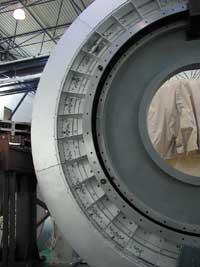
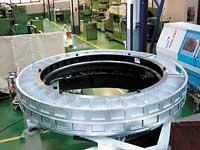
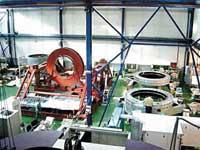
In addition to the basic giant mirror, the Grantecan telescope has two smaller mirrors. One of them, located at the top of the structure, has an approximate diameter of one meter. The other is between the basic giant mirror and the upper mirror. Also, instead of being concave, it is straight and inclined.
With these three mirrors the telescope will work in different ways. Grantecan can work with one, two or three mirrors.
Movements of the telescope
The function of the telescope seems simple. For example, look at a star and receive its light. But this simple thing is not so simple. Due to the rotation of the Earth, the telescope must be moved to follow the star.
To do this, the telescope has two movements: one that rotates the telescope with respect to its vertical axis and another that moves the telescope up and down.
The main movement is the one that puts the telescope on its feet and makes it turn on its vertical axis. To do this, an azimuth ring, a circular steel base, is placed at the base. In the azimuth ring is the turning drive and the turning encoder to know at all times the position of the telescope.
But turning on its axis is not enough to follow a celestial object, the telescope must also change its tilt. This is achieved by lifting device. This drive consists of two bearings, an engine and a measuring system to move the telescope up and down.
Therefore, the union of both movements allows to follow the object of the telescope at the point of the eye.
Instruments and rotation
In addition to the systems that govern the movement of the telescope, the instruments for the study of light are the core of the telescope: Instruments such as Cassegrain or Nasmyth.
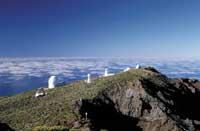
For example, nasmyth instruments are mounted on both sides of the telescope. These instruments rotate with the telescope so that the light reaches exactly. However, there is a small problem: there is a small difference between the movement of the telescope and the movement of the Nasmyth instruments, so both require independent turning systems. To do this, these instruments need the Nasmyth rotators, the rotators built by Tekniker.
These rotators have been Tekniker's main work in Grantecan. However, this has not been the only participation of the Basque technological center that simulated the mechanical behavior of the telescope structure before its construction. But there is no doubt that the rotators that have been references for the center have a great importance in the telescope.
Nasmyth rotators
Nasmyth rotators are discs 4 m long and weighing 6 tons. These rotators must move at a speed of 0.005 revolutions per minute, that is, they make a tour of 3 and a half hours. In addition, they can take several turns in a row, that is, 617º if necessary.
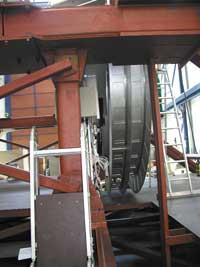
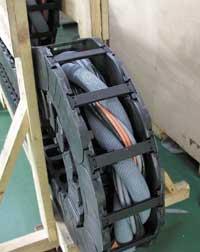
This demands great resistance, slow movements and precision. In addition, note that the Nasmyth instruments are directly attached to the rotators and are also very heavy, weighing up to 2,400 kg.
In addition to these features, Nasmyth rotators carry essential elements for instruments such as helium, dry compressed air or nitrogen to cool electronic devices and connection cables from the instrument to the telescope. All of them connect to a rotator panel and from there head to the main building.
Fighting with cables
These cables that connect Nasmyth instruments to the telescope are the heaviest load that rotators must bear. The fact is that the rotators must be able to lift and release the cables, otherwise there is risk of breaking the cables in rotation.
This problem was solved until now with a straight fixed lane or road, but this time it has been thought to place two lanes or circular lanes on the rotators themselves. In these routes will run braided wires, cable assemblies of 27 m in length. In this way, when the rotator is rotating, the cables that circulate along these tracks are released or collected together with the turn.
However, in addition to the risk of cable breakage, another aspect to consider is that when the rotator performs 617º there are 27 m of hanging cables, which weigh 600 kg. This requires enormous force to the rotator motor, as in addition to moving the Nasmyth instrument, it must bear the weight of the cables.
So it's not easy to follow a star and less when you have to move a giant telescope. From rotators to the complexity of the basic mirror is enough to detect the work involved. Giant work for the giant telescope.
Buletina
Bidali zure helbide elektronikoa eta jaso asteroko buletina zure sarrera-ontzian










